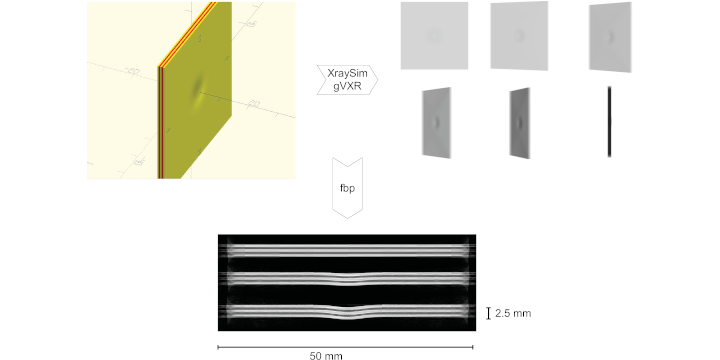Automated Porosity Characterization for Aluminum Die Casting Materials Using X-ray Radiography, Synthetic X-ray Data Augmentation by Simulation, and Machine Learning
Written by: by Stefan Bosse, Dirk Lehmhus and Sanjeev Kumar Published on:
Published on: Summary
Detection and characterization of hidden defects, impurities, and damages in homogeneous materials like aluminum die casting materials, as well as composite materials like Fiber–Metal Laminates (FML), is still a challenge. This work discusses methods and challenges in data-driven modeling of automated damage and defect detectors using measured X-ray single- and multi-projection images. Three main issues are identified: Data and feature variance, data feature labeling (for supervised machine learning), and the missing ground truth. It will be shown that simulation of synthetic measuring data can deliver a ground truth dataset and accurate labeling for data-driven modeling, but it cannot be used directly to predict defects in manufacturing processes. Noise has a significant impact on the feature detection and will be discussed. Data-driven feature detectors are implemented with semantic pixel Convolutional Neural Networks. Experimental data are measured with different devices: A low-quality and low-cost (Low-Q) X-ray radiography, a typical industrial mid-quality X-ray radiography and Computed Tomography (CT) system, and a state-of-the-art high-quality μ-CT device. The goals of this work are the training of robust and generalized data-driven ML feature detectors with synthetic data only and the transition from CT to single-projection radiography imaging and analysis. Although, as the title implies, the primary task is pore characterization in aluminum high-pressure die-cast materials, but the methods and results are not limited to this use case.
Award
Best paper award for tomography outreach tools - Vidal, F. P., Afshari, S., Ahmed, S., Atkins, C., Béchet, É., Corbí Bellot, A., ... Tugwell-Allsup, J. (2024). Müller, B., & Wang, G. (Eds.). "X-ray simulations with gVXR as a useful tool for education, data analysis, set-up of CT scans, and scanner development". Developments in X-Ray Tomography XV, SPIE Optics & Photonics 2024. DOI: 10.1117/12.3025315
Publications
- Bosse, S., Lehmhus, D., & Kumar, S. (2024). Automated porosity characterization for aluminum die casting materials using X-ray radiography, synthetic X-ray data augmentation by simulation, and machine learning. Sensors, 24(9). doi:10.3390/s24092933
- Vidal, F. P. et al (2024, Nov). X-ray simulations with gVXR as a useful tool for education, data analysis, set-up of CT scans, and scanner development. Developments in X-Ray Tomography XV, SPIE Optics & Photonics 2024. doi:10.1117/12.3025315 .
Citations
@Article{s24092933,
AUTHOR = {Bosse, Stefan and Lehmhus, Dirk and Kumar, Sanjeev},
TITLE = {Automated Porosity Characterization for Aluminum Die Casting Materials
Using X-ray Radiography, Synthetic X-ray Data Augmentation by Simulation,
and Machine Learning},
JOURNAL = {Sensors},
VOLUME = 24,
YEAR = 2024,
MONTH = may,
NUMBER = 9,
ISSN = {1424-8220},
DOI = {10.3390/s24092933}
}
@inproceedings{Vidal2024SPIE,
author = {Franck P. Vidal and Shaghayegh Afshari and Sharif Ahmed and
Carolyn Atkins and {\'E}ric B{\'e}chet and Alberto Corb{\'i} Bellot and
Stefan Bosse and Younes Chahid and Cheng-Ying Chou and Robert Culver and
Lewis Dixon and Johan Friemann and Amin Garbout and Cl{\'e}mentine Hatton and
Audrey Henry and Christophe Leblanc and Alberto Leonardi and
Jean Michel L{\'e}tang and Harry Lipscom and Tristan Manchester and
Bas Meere and Simon Middleburgh and Iwan Mitchell and Liam Perera and
Mart{\'i} Puig and Jenna Tugwell-Allsup},
title = {{X-ray simulations with gVXR as a useful tool for education,
data analysis, set-up of CT scans, and scanner development}},
volume = {13152},
booktitle = {Developments in X-Ray Tomography XV},
editor = {Bert M{\"u}ller and Ge Wang},
organization = {International Society for Optics and Photonics},
publisher = {SPIE},
pages = {131520W},
keywords = {X-ray imaging, Computed tomography (CT), Simulation,
Digital twinning, Graphics processor unit (GPU) programming,
Image registration, Digitally reconstructed radiograph (DRR),
Machine learning},
year = {2024},
doi = {10.1117/12.3025315},
}